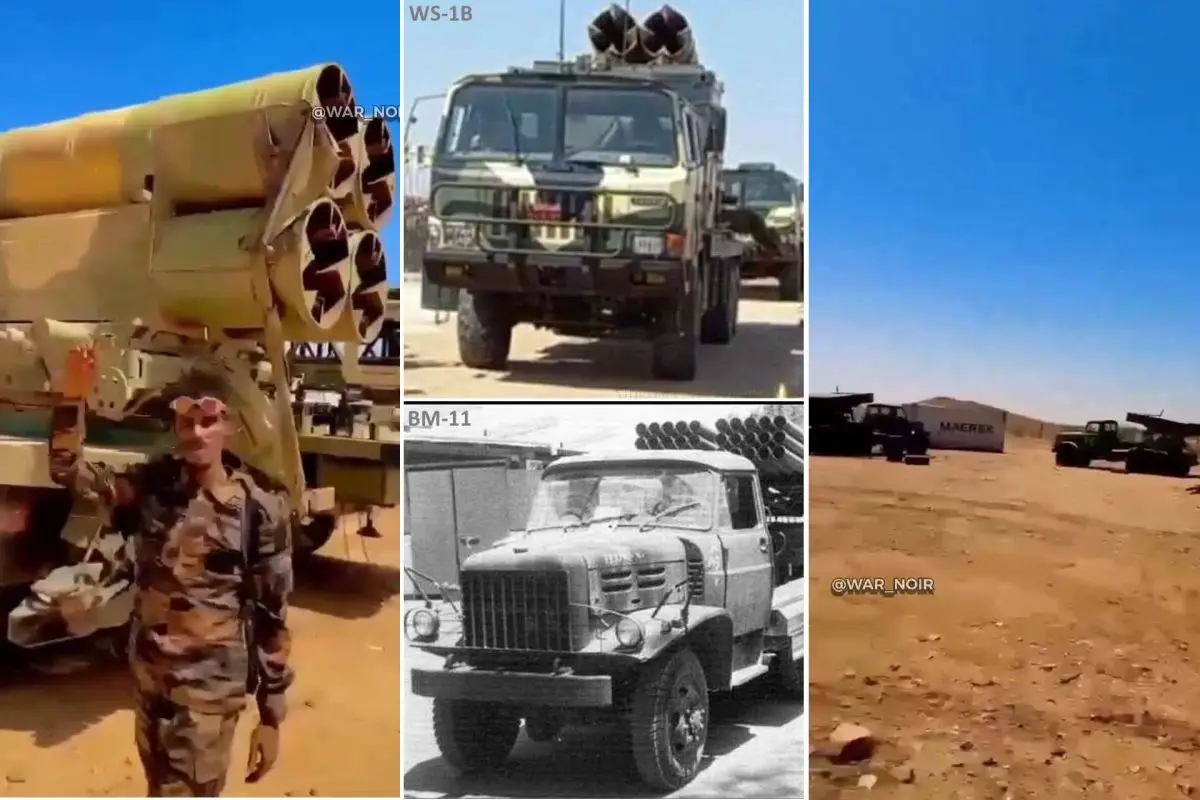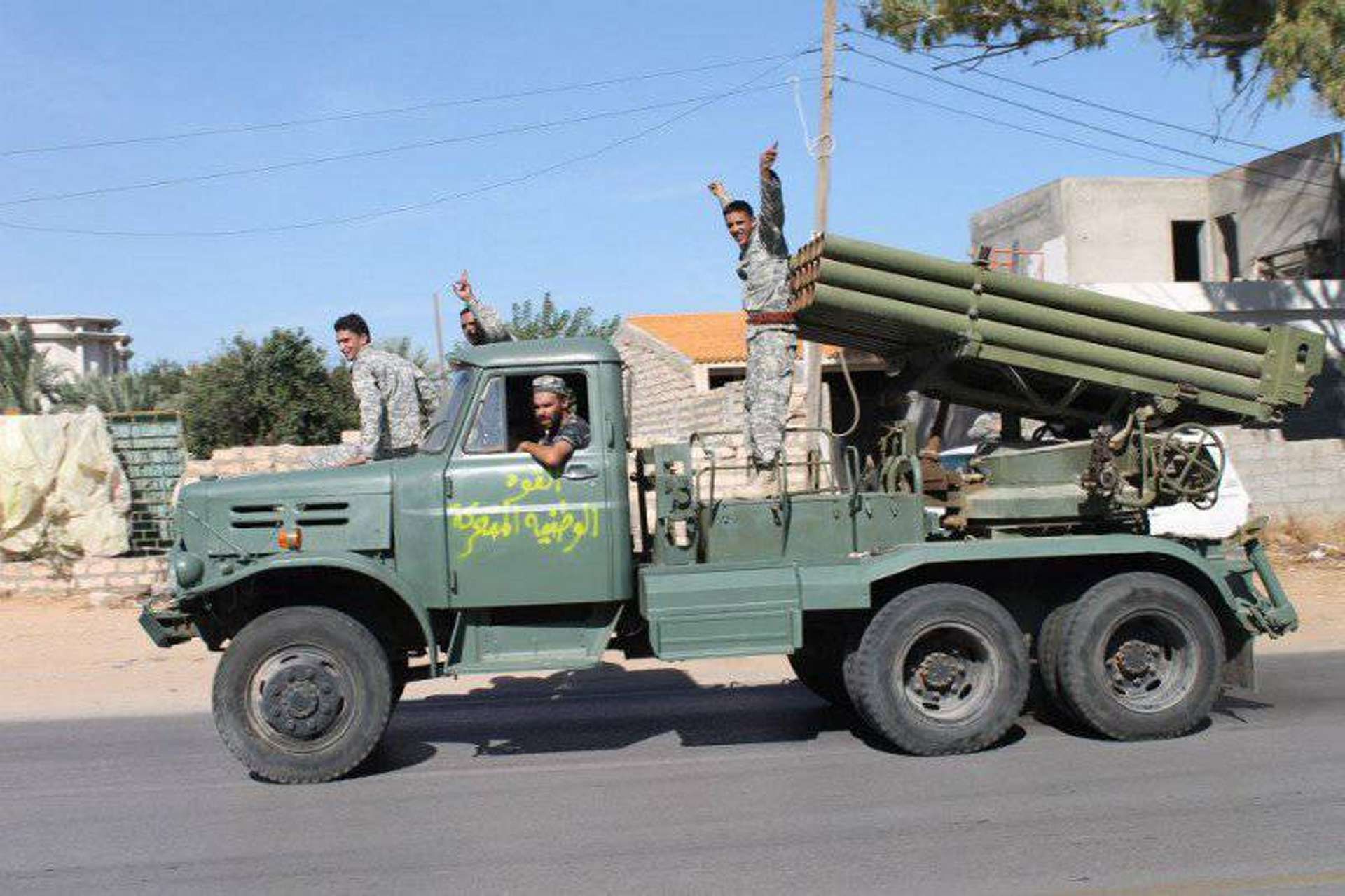Breaking News
Sudanese rebels capture Chinese WS-1B and North Korean BM-11 rocket launchers from the Sudanese Armed Forces.
On July 8, 2024, War Noir reported that the Sudanese Rapid Support Forces (RSF) released a video showcasing captured vehicles and rocket launchers from the Sudanese Armed Forces (SAF). Among the captured equipment were at least one Chinese 302mm Weishi WS-1B multiple launch rocket system (MLRS) and three North Korean BM-11 122mm MLRS units.
Follow Army Recognition on Google News at this link

Among the captured equipment were at least one Chinese 302mm Weishi WS-1B multiple launch rocket system (MLRS) and three North Korean BM-11 122mm MLRS units. (Picture source: Twitter/War Noir and Twitter/KPA_bot)
The Rapid Support Forces (RSF), a significant paramilitary group in Sudan, originated from the Janjaweed militias active during the Darfur conflict in the early 2000s. Officially established in 2013 to combat insurgents in Darfur, the RSF has grown considerably in strength and influence to become a key player in Sudanese politics and military affairs. It operates under the command of Mohamed Hamdan Dagalo, commonly known as Hemedti, and its leadership during the Darfur conflict was instrumental in the RSF's rise to prominence.
The group has been utilized by the Sudanese government to suppress uprisings and political dissent, including the 2019 crackdown on pro-democracy protests, and has faced numerous accusations of human rights abuses, including genocide, war crimes, and crimes against humanity. Despite efforts to bring the RSF under full military control, it maintained considerable autonomy and continued to be a significant force in Sudan until a full-scale civil war began on April 15, 2023, between the Sudanese Armed Forces (SAF), led by General Abdel Fattah al-Burhan, and the RSF, under the command of Hemedti.
The war started with an RSF attack on government sites, leading to intense fighting, particularly in Khartoum and the Darfur region. Both sides have been accused of committing atrocities, including widespread use of sexual violence, recruitment of children, and extensive torture. Despite various international attempts at mediation, including the Jeddah Declaration, the conflict continues unabated, resulting in a severe humanitarian crisis. More than 14,000 people have been killed, and around 8.6 million have been displaced, with millions facing acute food insecurity and potential famine. The conflict has severely disrupted Sudan’s economy, leading to an 18.3% projected contraction in 2024, and has devastated livelihoods, education, and healthcare infrastructure.
On May 18, 2019, Sudanese news reported that the Sudanese government forces used the China-made WS-1B long-range rocket launcher for the first time to bombard Sudanese rebels. Sudan acquired the WS-1B production line through the Sudan Military Industrial Corporation, and it is assembled locally. The introduction of this weaponry in one of the several Sudanese civil wars marked the first use of Chinese-made long-range rocket launchers in Africa.

The Sudanese government forces used the China-made WS-1B long-range rocket launcher for the first time in 2019 to bombard rebels, marking the first use of Chinese-made long-range rocket launchers in Africa. (Picture source: Twitter/War Noir)
The WS-1B, a 302 mm MLRS, is part of the WeiShi family of rockets developed by the Chinese company Sichuan Aerospace Industry Corporation (SCAIC). Development of this family began in the 1980s, focusing on enhancing long-range artillery capabilities. The original WS-1 system underwent trials in 1990, and its modernized version, the WS-1B, was first demonstrated in 1993. The WS-1B is designed to target critical enemy assets deep within their defenses, including military bases, troop concentrations, missile launchers, airports, transportation hubs, and industrial centers. Although not adopted by the Chinese People's Liberation Army (PLA), the WS-1B was marketed internationally by China National Precision Machinery Corporation (CPMIEC). In 1996, a contract was signed with Turkey, leading to the supply of WS-1 systems and local production of upgraded versions, known as "Kasirga" and "Jaguar."
The WS-1B system consists of the HF-4B launcher, mounted on a Tiema XC2200 6x6 truck chassis, the QY-4B (QY-88B) transport and charging machine, and the DZ-88B command post. The launcher includes four cylindrical cross-shaped guides capable of vertical and azimuthal adjustments, allowing for deployment within 20 minutes. The DZ-88B command post is equipped with communication systems, GPS, meteorological instruments, and a digital firing control system, operated by a crew of five. An alternative configuration includes a six-guide launcher on an 8x8 chassis.
The WS-1B rockets use the FG-43 solid fuel engine, reaching a maximum range of up to 180 km and a flight speed of 5.2M. The system's munitions include the ZDB-2 fragmentation warhead and the SZB-1 cluster munition. The ZDB-2 warhead contains a 70 kg explosive charge with 26,000 fragments, while the SZB-1 includes 466 cumulative shrapnel elements. Both warheads are designed for effectiveness, with the rockets achieving a circular probable deviation (CEP) of 1-1.25%. The WS-1B's battery configuration includes a DZ-88B command post, 6-9 HF-4 launchers, and an equal number of QY-88B transport and charging machines, each carrying 20 rounds of ammunition.

The BM-11 is mounted on various 6x6 all-terrain vehicle chassis, including the Soviet ZIS-151, a Chinese copy of the ZIL-157 known as the FAW Jiefang CA-30, and domestically produced copies of the Japanese Isuzu HTW 11 truck. (Picture source: Twitter/KPA_bot)
The other MLRS captured by the Rapid Support Forces (RSF), the BM-11, was introduced in 1963 as a North Korean adaptation of the Russian BM-21 MLRS. This modified version features a reduced number of rocket guides, with 30 tubes instead of the original 40, making it a lighter variant of its predecessor. The BM-11 is mounted on various 6x6 all-terrain vehicle chassis, including the Soviet ZIS-151, a Chinese copy of the ZIL-157 known as the FAW Jiefang CA-30, and domestically produced copies of the Japanese Isuzu HTW 11 truck. BM-11 units have been observed in countries such as Libya, Sudan, and Iran.
The BM-11 operates with a crew of five and has displacement and emplacement times of three and two minutes, respectively. The system lacks armor. As a multiple rocket launcher, the BM-11 uses a turntable mount and can fire a range of 122mm rockets, compatible with standard Russian, Chinese, and North Korean munitions. Its maximum firing range is estimated at 20,500 meters, with a rate of fire of two rounds per second, capable of delivering a full salvo in 15 seconds. Reloading the system takes approximately 8 to 9 minutes.
The chassis configuration of the BM-11 is primarily 6x6, supporting off-road capability for varied terrain in military operations. This design allows the BM-11 to be deployed from various platforms, contributing to its operational flexibility. Despite the lack of armor, the BM-11's rapid deployment and firing capabilities offer substantial firepower support in a compact and mobile package. Its design and adaptations reflect North Korea's approach to modifying or copying existing military technology to meet its defense needs.


























